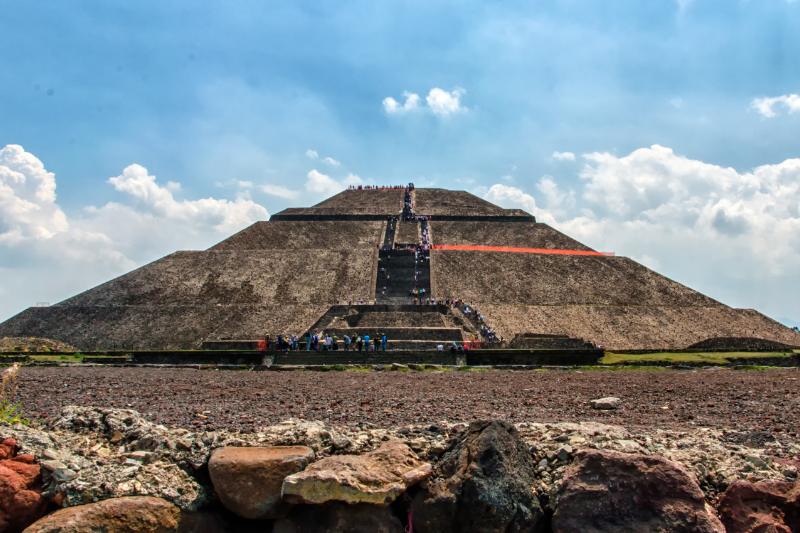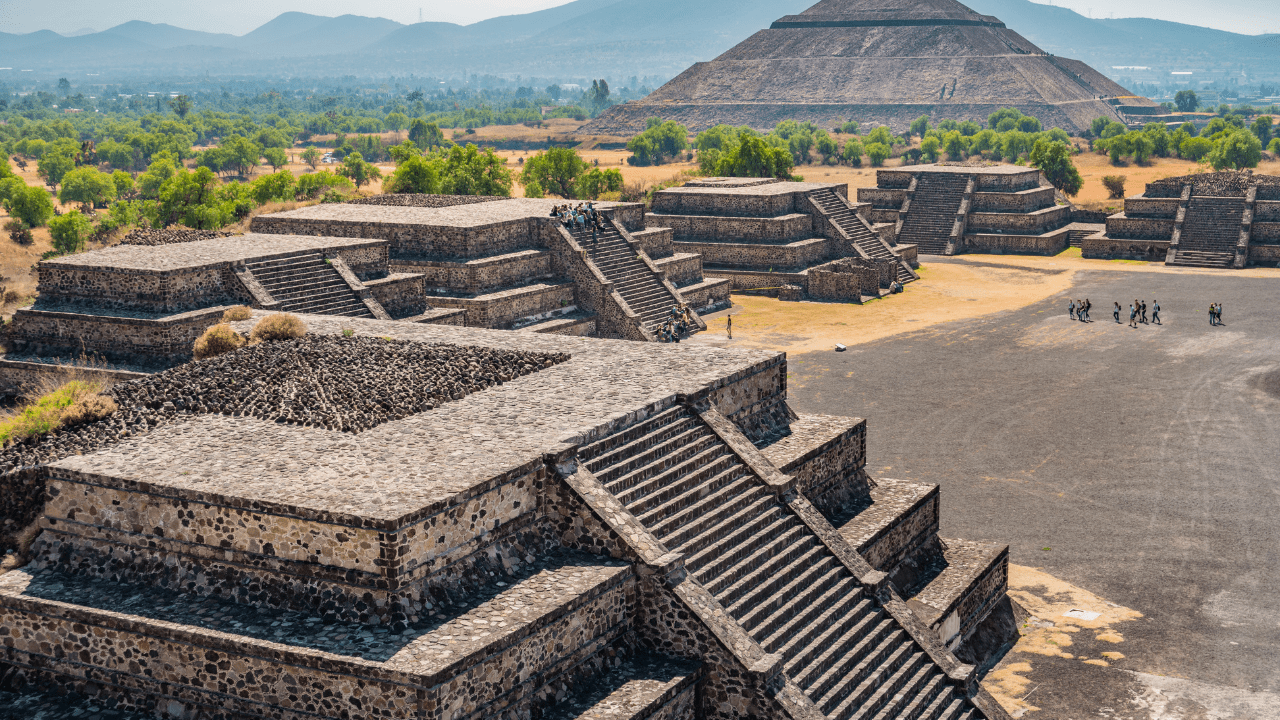Welcome to the enchanting world of the Teotihuacan Pyramids, nestled in the heart of Mexico’s cultural heritage.
Prepare to embark on a captivating journey through time as we explore the intriguing history, cultural significance, majestic pyramids, and thrilling activities that await you at this extraordinary archaeological site.
Teotihuacan, a UNESCO World Heritage site, is located just 30 miles northeast of Mexico City. This proximity makes it a convenient and must-visit destination for travelers eager to immerse themselves in the wonders of ancient Mesoamerica.
In just a short distance from the bustling streets of Mexico City, you’ll find yourself transported to a realm of awe-inspiring archaeological treasures.
Getting to Teotihuacan is a breeze. From Mexico City, you can easily reach this archaeological wonderland by various means of transportation.
If you prefer public transport, hop on a comfortable bus from the Autobuses del Norte station in Mexico City, offering regular departures to Teotihuacan.
Alternatively, you can opt for a guided tour that includes transportation, giving you the convenience of a hassle-free trip while learning from knowledgeable guides.
To make the most of your visit, consider planning your trip on weekdays, particularly Tuesdays through Fridays.
These days tend to be less crowded, allowing you to explore the pyramids and immerse yourself in the ancient atmosphere without the hustle and bustle of larger crowds.
However, if weekends are your only option, fear not, as Teotihuacan’s timeless beauty is bound to captivate you regardless of the day.

Unearthing the History of Teotihuacan Pyramids
Teotihuacan, believed to have been founded around 150 BCE, was home to a vibrant and sophisticated civilization.
The city thrived for centuries, with its peak occurring between 150 CE and 450 CE. During this time, Teotihuacan became one of the largest urban centers in the world, boasting a population estimated to be over 100,000 people.
The exact identity of the people who built and inhabited Teotihuacan remains a mystery. The city’s name itself is derived from the Aztecs, who discovered the ruins centuries later and named it “Teotihuacan,” meaning “the place where the gods were created” in their language.
It is believed that the original builders referred to their city as something different, and their true identity and language remain unknown.
Teotihuacan’s construction occurred in several distinct phases, showcasing the ingenuity and vision of its architects and builders.
The earliest phase, known as the “Preclassic Period” (150 BCE to 300 CE), witnessed the construction of the iconic Pyramid of the Sun, the Temple of the Feathered Serpent (also known as the Pyramid of the Moon), and the Avenue of the Dead, the city’s main thoroughfare.
During the subsequent “Classic Period” (300 CE to 600 CE), the city experienced a significant expansion and urban development.
Additional temples, palaces, and residential areas were constructed, solidifying Teotihuacan’s status as a major cultural and economic hub.
The city’s grid-like layout and meticulously planned architecture reflected a highly organized society.
As for the primary economic activity in Teotihuacan, agriculture played a vital role in sustaining the city’s population.
The inhabitants cultivated maize, beans, squash, and other crops in the surrounding fertile lands, ensuring a steady food supply.
Furthermore, Teotihuacan thrived as a prominent center of trade and commerce, bustling with the production and exchange of various goods.
Artisans skillfully crafted exquisite obsidian artifacts, intricate pottery, and vibrant textiles that captivated both locals and visitors.
The Cultural Significance
Teotihuacan held immense cultural significance for its region, leaving behind a profound impact on Mesoamerican civilization. Over the years, this ancient city made remarkable cultural contributions that continue to intrigue and inspire us today. Let’s delve into some of the most significant cultural legacies of Teotihuacan.
Its urban planning and architectural prowess were nothing short of extraordinary. The city’s grid-like layout, carefully designed streets, and monumental structures showcased an advanced understanding of urban organization.
The awe-inspiring pyramids, palaces, and residential complexes displayed the ingenuity and engineering skills of its inhabitants, leaving a lasting legacy of architectural marvels.
Teotihuacan was a haven for artistic expression. Intricate murals adorned the walls of its buildings, depicting vibrant scenes of daily life, religious ceremonies, and mythological narratives.
The artistry and attention to detail showcased in these murals provide valuable insights into the beliefs, customs, and cultural practices of the Teotihuacan people.
Religion held a central place in Teotihuacan’s culture. The city was a sacred site where rituals and ceremonies played a vital role in the lives of its inhabitants.
Elaborate temples and pyramids were dedicated to various deities, with the Feathered Serpent (Quetzalcoatl) being one of the most prominent.
Teotihuacan’s religious practices and cosmological beliefs greatly influenced subsequent Mesoamerican civilizations.
In addition to its strategic location, Teotihuacan’s cultural importance was further enhanced by its role as a hub for extensive trade networks.
The city served as a central point for the exchange of goods, ideas, and cultural influences, connecting diverse regions
The Majestic Teotihuacan Pyramids
Teotihuacan is home to several magnificent pyramids that continue to captivate visitors with their grandeur and historical significance.
Let’s explore these awe-inspiring structures and learn about their dedications and locations within the archaeological site.
Pyramid of the Sun
Rising proudly as the largest structure in Teotihuacan, the Pyramid of the Sun stands at the heart of the city.
This monumental pyramid is dedicated to the deity of the sun. Ascending its steps rewards you with breathtaking panoramic views of the surrounding landscape, allowing you to feel the vastness of this ancient metropolis.
Pyramid of the Moon
Situated at the northern end of the Avenue of the Dead, the Pyramid of the Moon is a testament to the spiritual beliefs of the Teotihuacan people.
This magnificent pyramid is dedicated to the goddess of water and fertility. Its striking presence, adorned with intricate carvings, offers a glimpse into the religious practices and cosmological significance that shaped Teotihuacan’s culture.
Temple of the Feathered Serpent (Pyramid of the Feathered Serpent)
Also known as the Temple of the Feathered Serpent or the Pyramid of Quetzalcoatl, this pyramid stands out with its intricate stone carvings depicting the feathered serpent deity.
Located in the southern part of the site, this pyramid highlights the importance of the god Quetzalcoatl in Teotihuacan’s religious and cultural traditions.
Each of these pyramids showcases the architectural prowess and spiritual devotion of the Teotihuacan civilization.
Exploring their massive structures and intricate details allows us to marvel at the ingenuity and artistry of this ancient culture, while also offering a deeper understanding of their religious beliefs and cultural practices.

